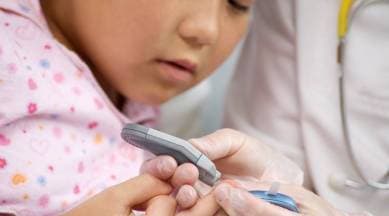‘Diabesity’: The double burden of diabetes and obesity in children
The stunning rise in obesity translates to one in every 10 Indian children being prone to type 2 diabetes according to the World Health Organisation. Till 30 years ago, type 2 diabetes in children and young adults was nonexistent.

By Dr Karthik Balachandran
While November 14 is celebrated as Children’s Day in India, interestingly, it is also the same day that World Diabetes Day is observed around the world. While it is known that Indian children face the double burden of malnutrition and rising risk of non-communicable diseases including diabetes, what is alarming is the rise in the number of children being diagnosed with the disease. This has triggered critical warnings among families and health organisations.
monthly limit of free stories.
with an Express account.
As per the Comprehensive National Nutrition Survey (CNNS) 2016-18, one in 10 school-age children and adolescents in the country is a pre-diabetic, one in 100 children is a full-blown diabetic. The survey, which used gold standard methods to assess anaemia, micronutrient deficiencies and biomarkers of NCDs for the first time in India, was conducted by the Union Ministry of Health and Family Welfare and Unicef along with the Population Council.
Over the last couple of decades, there has been a tectonic shift in the lifestyle of families. High-calorie diet, junk/fast food consumption and lack of physical and outdoor activities have increased waistlines of individuals, and critically among children as well. It is hard to tell if the future is more bitter or less sweet. It’s a dual epidemic as obesity is on the rise and blood sugar levels are increasing concurrently. While experts have coined the word ‘Diabesity’ for the prevalence of diabetes and obesity in children, the World Health Organisation has described the situation as an “exploding nightmare”.
Type 1 and type 2 diabetes are different diseases, but they both affect the body’s use of insulin. Type 1 diabetes in children, previously called juvenile diabetes, occurs when the pancreas is unable to produce insulin and without insulin, sugar cannot travel from the blood into the cells, and high blood sugar levels can result. Meanwhile, type 2 diabetes is less common in young children, but it can occur when insulin is not working properly and without enough insulin, glucose can accumulate in the bloodstream. Here are a few symptoms to watch out in children:
- Abnormal weight gain or loss
- Slow healing of wounds
- Increase in thirst and frequency of urination
- Increase in fatigue
- Blurred vision
- Irritability or behavioral changes
- Abdominal pain
The several risk factors in children for developing diabetes include family history, genetic susceptibility, race, diet and certain viruses. If blood sugar levels aren’t well-controlled over a prolonged period of time, diabetes complications can eventually be disabling or even life-threatening including kidney damage, eye damage, nerve damage, skin conditions and heart diseases. The stunning rise in obesity translates to one in every 10 Indian children being prone to type 2 diabetes according to the World Health Organisation. Till 30 years ago, type 2 diabetes in children and young adults was nonexistent.
The technological advances have changed the way diabetes was treated earlier replacing conventional methods such as advances in insulin delivery devices, better insulin pens, artificial pancreas, monitoring glucose levels, use of telemedicine and diabetes apps in mobile phones. The success of these technological advances will rely significantly on the willingness of patients and doctors to adopt them and to utilise them to the fullest. Prevention must take the highest priority and should focus on decreasing the risk, incidence and consequences of diabetes especially in children.
Is your child obese? It might be because of lack of good sleep
Parents can do a lot to help their kids prevent diabetes. Healthy lifestyle changes become habits more easily when everyone does them together. Here are some tips that need to be followed:
- Get more active. Go for walks, play ball, or go to the park. Kids need at least 60 minutes of activity a day.
- Cut back on sugar. Limit sugar-sweetened drinks and juice.
- Offer healthy snacks. Focus on vegetables, fruits and whole grains.
- Limit screen time. That includes TVs, computers, tablets and phones.
- Eat dinner as a family. Keep the TV turned off.
- See a dietician. Visit a dietician if a child displays any of the above symptoms.
Individuals, parents and caregivers must take the step forward and care for the well-being of children. Keeping a strict eye on the blood glucose levels of your child, avoiding lows and highs, can be a large part of being the parent of a child with diabetes. Parents must be aware that children with diabetes have diet restrictions and that their activity levels need to be closely monitored.
(The writer is Consultant Endocrinologist, Sri Ramachandra Medical Center, Chennai.)